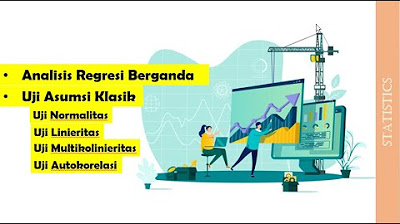Modul 12 (StatSos2) - Konsep Dasar Regresi Linear Sederhana
Summary
TLDRThis video provides an in-depth explanation of simple linear regression analysis. It contrasts regression with correlation, emphasizing that while both methods explore relationships between two variables, regression focuses on the influence of independent variables on dependent ones. The video discusses regression model components, such as the dependent and independent variables, and the Ordinary Least Squares method for estimating parameters. It covers statistical tests for significance, including partial and simultaneous tests, and explores how the correlation coefficient and coefficient of determination measure the relationship and influence between variables. The content concludes by applying regression techniques to practical examples.
Takeaways
- 😀 Regression analysis models the functional relationship between two variables, where one variable is a predictor of the response variable.
- 😀 The main difference between correlation and regression is that correlation examines relationships, while regression focuses on the influence of independent variables on dependent variables.
- 😀 Regression requires clear identification of the independent and dependent variables, whereas correlation does not rely on this distinction.
- 😀 Simple linear regression uses one independent variable, while multiple regression involves multiple independent variables.
- 😀 A basic simple linear regression model is represented by the equation: y = a + bX + ε.
- 😀 In regression, the primary objectives include determining the relationship between variables, testing the influence, and making predictions.
- 😀 The Ordinary Least Squares (OLS) method is used to estimate the parameters (a and b) in simple linear regression.
- 😀 Partial significance tests are used to assess whether the estimated parameters (constant 'a' and coefficient 'b') have a significant effect on the dependent variable.
- 😀 Simultaneous significance tests are used in multiple regression to assess the combined influence of multiple independent variables on the dependent variable.
- 😀 The correlation coefficient measures the strength of the relationship between variables, while the coefficient of determination indicates how much the independent variable influences the dependent variable.
- 😀 The results of regression analysis, such as correlation and determination coefficients, can be interpreted using formulas like Pearson's correlation or simplified calculation methods.
Q & A
What is the main goal of regression analysis?
-Regression analysis aims to explain the functional relationship between two variables, where one variable predicts or influences the other.
How does regression differ from correlation?
-While both regression and correlation discuss the relationship between two variables, regression focuses on the influence of independent variables on a dependent variable, whereas correlation simply discusses the strength and direction of the relationship without considering causality.
What are the key objectives of regression analysis?
-The three main objectives of regression analysis are: understanding the relationship between two variables, conducting an influence test, and making predictions or forecasts based on the model.
What is an example of a regression analysis scenario?
-An example is analyzing the effect of promotional costs (independent variable) on sales (dependent variable). In this case, the independent variable influences the dependent variable.
What types of variables are involved in linear regression?
-In linear regression, both the independent variable (predictor) and dependent variable (response) should be numerical and at least interval scale data.
What are the two ways to collect data in regression analysis?
-Data can be collected in two ways: first, by determining the independent variable (x) and then measuring the dependent variable (y), or second, by measuring both variables simultaneously.
What is the role of the error term (epsilon) in regression analysis?
-The error term (epsilon) reflects the random variation or discrepancy between the actual values and the predicted values of the dependent variable. It is assumed to follow a normal distribution with a mean of zero and variance sigma squared.
What is the difference between simple and multiple linear regression?
-Simple linear regression involves only one independent variable, whereas multiple linear regression involves more than one independent variable to explain the variation in the dependent variable.
What is the Ordinary Least Squares (OLS) method used for in regression analysis?
-The OLS method is used to estimate the values of the regression coefficients (a and b) by minimizing the sum of the squared differences between the observed and predicted values of the dependent variable.
What is the significance of hypothesis testing in regression analysis?
-Hypothesis testing in regression analysis is used to determine whether the regression coefficients (such as the constant and slope) significantly affect the dependent variable. This is typically done using t-tests and significance levels (alpha).
Outlines

このセクションは有料ユーザー限定です。 アクセスするには、アップグレードをお願いします。
今すぐアップグレードMindmap

このセクションは有料ユーザー限定です。 アクセスするには、アップグレードをお願いします。
今すぐアップグレードKeywords

このセクションは有料ユーザー限定です。 アクセスするには、アップグレードをお願いします。
今すぐアップグレードHighlights

このセクションは有料ユーザー限定です。 アクセスするには、アップグレードをお願いします。
今すぐアップグレードTranscripts

このセクションは有料ユーザー限定です。 アクセスするには、アップグレードをお願いします。
今すぐアップグレード関連動画をさらに表示

Teori Regresi Linier Sederhana (Part 1) - Statistika Parametrik

(1/4) Analisis Regresi : Uji asumsi Klasik

35. Regressione Lineare Semplice (Spiegata passo dopo passo)

KULIAH STATISTIK - ANALISIS REGRESI

Data Mining 10 - Estimation (Linear Regression)

Simple Linear Regression Simplified | Orange Data Mining Tutorial
5.0 / 5 (0 votes)
